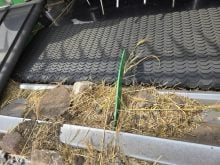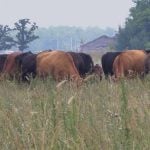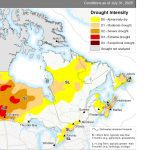Al Lowe’s fields were so saturated last spring that water was seeping out of the hillsides and his seeding rig would slide down the side slopes.
“But we kept going. If I could get the tractor through it, the seeding rig would seed and the packer would push it in,” said Lowe, who farms near Meachem, Sask.
“I have really sticky clay here, but I don’t think I plugged more than two runs the whole time.”
Read Also

Alberta eases water access for riparian restoration
Alberta government removes requirement for temporary diversion licence to water plants up to 100 cubic metres per day for smaller riparian restoration projects
Lowe runs Atom Jet openers with TechnoTill packers, which he’s had for seven years, but 2010 was the first time he ran them in extreme mud.
“The packers just slide along in the mud. They didn’t gum up or anything.
“I was sliding sideways on the side hills, but I just kept seeding. I even seeded running downhill sometimes because I couldn’t pull it uphill.”
Lowe said he was still seeding feed barley for his cattle in July. Whenever a 20 or 30 acre spot dried up enough to get into, he went seeding.
“I’m glad we did that because anywhere we had some kind of crop growing, it dried up a lot more in the fall than the unseeded acres.
“We got germination everyplace we pulled the seeder. Of course, the hollows all flooded out from the rain that came later.”
He said his 2010 yield was nothing to brag about, but it was better than no crop at all. His peas averaged 30 bushels and the canola ran 20 to 25 bu. The barley was swath grazed in the fall.
“Most of the neighbours around here with the modern parallel linkage drills couldn’t seed because the packer wheels jammed up with mud.”
Allan Kormos said he’d rather fight drought than moisture.
“Dry prairie conditions are what we’re used to here,” said Kormos of Cardston Alta.
“That’s what we’re equipped for and that’s what all our machinery is designed for. Most of my farm is on heavy land. It’s not quite gumbo, but very heavy, so it’s no fun when we get this much rain.”
Although he managed to seed all of his 2,000 acres last year, subsequent rain either flooded out the low spots or washed away most of the nutrients.
“After seeding was finally finished, we’d get a four inch rain. Then we’d get three inches the next day. This happened over and over. The crop all germinated, but the rain did us in.”
Kormos seeded with a Morris 8900 outfitted with Atom Jet openers and TechnoTill packers. It was his sixth year using the packing plates instead of wheels.
“We could go when and where other guys couldn’t go. The TechnoTills didn’t even push the mud. They somehow keep themselves clean.”
Kormos said farmers in the area with packing wheels constantly plugged with mud.
“A lot of guys ended up dropping the wheels. The shanks didn’t seem to plug, but the packers jammed up with mud so they stopped turning. The big mud balls would just skid along.”
He thinks geometry is one of the reasons the packing plates work in the mud. He runs the adjustable plates with the lead edge slightly higher than the back edge.
“The back edge of the plate has more contact with the soil or the mud, so the plate behaves like a ski or a sled.”
Neighbouring farmers who did manage to get their packing wheels working found they had a crusting problem whenever they got a few sunny days.
“For whatever reason, and I don’t understand it, we didn’t experience much crusting at all. Maybe it’s our residue? I don’t know.”
Kormos said his barley averaged 50 to 55 bu. Canola on the better drained land averaged 42 bu., but canola on flat fields ran 15 to 18 bu.
Mike Syroteuk of Burr, Sask., seeded 1,400 of a possible 2,000 acres last year. It was his second year with TechnoTill packing plates on his JD 610 cultivator.
“A lot of guys in our area hardly seeded at all, so I suppose we were lucky,” he said.
“All we would need is a couple sunny days to dry the surface a little bit, and we could just go.”
He said his soil is heavy with a bit of clay and sand.
“We mudded some in into some really sloppy stuff, but that didn’t work too well. Wherever it wasn’t too wet, we got good germination. But even in those spots, we had a lot of disease problems because of all that moisture.”
Syroteuk said his barley yielded 15 to 50 bu. per acre, while canola and wheat were around 20 bu.
TechnoTill boss Betty Schoenhofer said there are four reasons why mud doesn’t jam up on packing plates:
• the metal compound is a form of chrome plus nickel alloy, so it has a smooth surface;
• only a thin layer of soil is packed over the seed row;
• the packer plate is under pressure, so mud doesn’t have much opportunity to build up;
• air seeders tend to be lighter than drills, so there’s less weight to drag through the mud.
For more information, contact Lowe at 306-376-4420, Kormos at 403-653-3299, Syroteuk at 306-682-3232 or visit www.technotill.com .

















